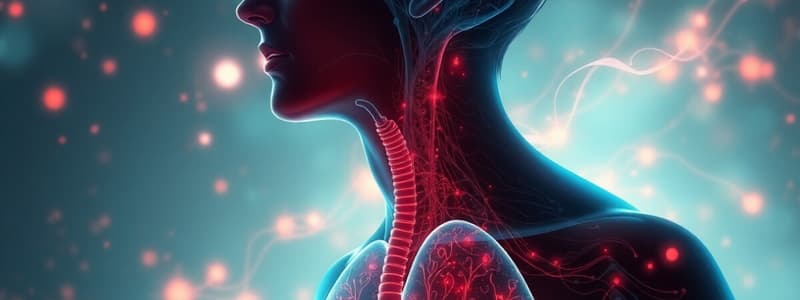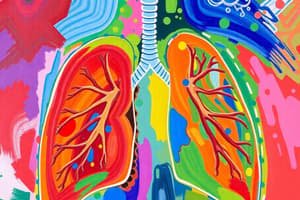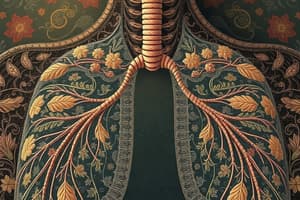Podcast
Questions and Answers
What is a common symptom of pulmonary embolism?
What is a common symptom of pulmonary embolism?
- Chest tightness
- Productive cough
- Chronic cough
- Sudden dyspnea (correct)
Which of the following conditions is characterized by chest pain that worsens with breathing or coughing?
Which of the following conditions is characterized by chest pain that worsens with breathing or coughing?
- Tuberculosis
- Asthma
- Pneumonia
- Pleurisy (correct)
Which buffering mechanism involves the excretion or reabsorption of H⁺ and HCO₃⁻?
Which buffering mechanism involves the excretion or reabsorption of H⁺ and HCO₃⁻?
- Respiratory regulation
- Renal regulation (correct)
- Hemodynamic regulation
- Bicarbonate buffer system
What type of pneumothorax occurs without any trauma?
What type of pneumothorax occurs without any trauma?
What primary system does the body use to quickly react to changes in pH?
What primary system does the body use to quickly react to changes in pH?
What condition is indicated by a blood pH that rises above 7.45?
What condition is indicated by a blood pH that rises above 7.45?
Which buffer system is primarily responsible for regulating pH in the blood?
Which buffer system is primarily responsible for regulating pH in the blood?
What effect does increased levels of carbon dioxide have on blood pH?
What effect does increased levels of carbon dioxide have on blood pH?
What is metabolic alkalosis primarily associated with?
What is metabolic alkalosis primarily associated with?
What would primarily lead to respiratory acidosis?
What would primarily lead to respiratory acidosis?
What is the primary function of lymphatic vessels?
What is the primary function of lymphatic vessels?
What is the primary cause of Respiratory Acidosis?
What is the primary cause of Respiratory Acidosis?
Which structure is primarily involved in the maturation of T-cells?
Which structure is primarily involved in the maturation of T-cells?
What type of immunity is characterized by the production of antibodies after exposure to a pathogen?
What type of immunity is characterized by the production of antibodies after exposure to a pathogen?
Which of the following is a characteristic of Metabolic Alkalosis?
Which of the following is a characteristic of Metabolic Alkalosis?
What is the volume of air that remains in the lungs after forced expiration known as?
What is the volume of air that remains in the lungs after forced expiration known as?
What is the main role of the spleen in the immune system?
What is the main role of the spleen in the immune system?
Which organ is responsible for maturing T lymphocytes?
Which organ is responsible for maturing T lymphocytes?
Which lymphatic duct drains lymph from the right side of the head, neck, and arm?
Which lymphatic duct drains lymph from the right side of the head, neck, and arm?
What type of immunity is acquired through natural infection?
What type of immunity is acquired through natural infection?
Which of the following is NOT part of the upper respiratory tract?
Which of the following is NOT part of the upper respiratory tract?
Which condition is characterized by swelling due to lymphatic obstruction?
Which condition is characterized by swelling due to lymphatic obstruction?
What is one characteristic of lymphatic capillaries that distinguishes them from blood capillaries?
What is one characteristic of lymphatic capillaries that distinguishes them from blood capillaries?
Which immune response is considered a non-specific defense mechanism?
Which immune response is considered a non-specific defense mechanism?
Which structure is primarily responsible for filtering blood and recycling red blood cells?
Which structure is primarily responsible for filtering blood and recycling red blood cells?
What is the total lung capacity if the vital capacity is approximately 4800 mL and the residual volume is approximately 1200 mL?
What is the total lung capacity if the vital capacity is approximately 4800 mL and the residual volume is approximately 1200 mL?
What primary function do the vocal cords serve in the larynx?
What primary function do the vocal cords serve in the larynx?
Which structure acts as a gateway to the trachea and prevents food from entering the airways?
Which structure acts as a gateway to the trachea and prevents food from entering the airways?
What is the purpose of cilia lining the trachea?
What is the purpose of cilia lining the trachea?
What is the volume of air exchanged during normal breathing known as?
What is the volume of air exchanged during normal breathing known as?
What primarily occurs in the alveoli?
What primarily occurs in the alveoli?
Which term describes the exchange of gases between blood and the tissues?
Which term describes the exchange of gases between blood and the tissues?
What occurs during expiration?
What occurs during expiration?
What is indicated by blood pH falling below 7.35?
What is indicated by blood pH falling below 7.35?
What muscles primarily contract during inspiration?
What muscles primarily contract during inspiration?
Which of the following breathing patterns indicates rapid, shallow breathing?
Which of the following breathing patterns indicates rapid, shallow breathing?
What happens to intrapulmonary pressure during expiration?
What happens to intrapulmonary pressure during expiration?
What is the primary characteristic of Cheyne-Stokes respiration?
What is the primary characteristic of Cheyne-Stokes respiration?
During which respiratory process does oxygen diffuse into the pulmonary capillaries?
During which respiratory process does oxygen diffuse into the pulmonary capillaries?
What typically characterizes Kussmaul respiration?
What typically characterizes Kussmaul respiration?
Which condition is a component of Chronic Obstructive Pulmonary Disease (COPD)?
Which condition is a component of Chronic Obstructive Pulmonary Disease (COPD)?
What is hyperventilation characterized by?
What is hyperventilation characterized by?
Flashcards
Asthma
Asthma
Airway narrowing caused by inflammation and muscle tightening. Leads to wheezing, shortness of breath, and chest tightness.
Pneumonia
Pneumonia
Inflammation of the tiny air sacs (alveoli) in the lungs, usually caused by infection. Common symptoms include productive cough, fever, and difficulty breathing.
Pneumothorax
Pneumothorax
Lung condition where air leaks into the space between the lung and chest wall, causing the lung to collapse. Can be spontaneous (without injury) or traumatic.
Pleural Effusion
Pleural Effusion
Signup and view all the flashcards
Bicarbonate Buffer System
Bicarbonate Buffer System
Signup and view all the flashcards
Inspiration (Inhalation)
Inspiration (Inhalation)
Signup and view all the flashcards
Expiration (Exhalation)
Expiration (Exhalation)
Signup and view all the flashcards
External Respiration
External Respiration
Signup and view all the flashcards
Internal Respiration
Internal Respiration
Signup and view all the flashcards
Eupnea
Eupnea
Signup and view all the flashcards
Tachypnea
Tachypnea
Signup and view all the flashcards
Bradypnea
Bradypnea
Signup and view all the flashcards
Dyspnea
Dyspnea
Signup and view all the flashcards
Respiratory Acidosis
Respiratory Acidosis
Signup and view all the flashcards
Respiratory Alkalosis
Respiratory Alkalosis
Signup and view all the flashcards
Metabolic Acidosis
Metabolic Acidosis
Signup and view all the flashcards
Metabolic Alkalosis
Metabolic Alkalosis
Signup and view all the flashcards
Tidal Volume (TV)
Tidal Volume (TV)
Signup and view all the flashcards
Inspiratory Reserve Volume (IRV)
Inspiratory Reserve Volume (IRV)
Signup and view all the flashcards
Expiratory Reserve Volume (ERV)
Expiratory Reserve Volume (ERV)
Signup and view all the flashcards
Residual Volume (RV)
Residual Volume (RV)
Signup and view all the flashcards
What are alveoli?
What are alveoli?
Signup and view all the flashcards
What is vital capacity?
What is vital capacity?
Signup and view all the flashcards
What is residual volume?
What is residual volume?
Signup and view all the flashcards
What is inspiration?
What is inspiration?
Signup and view all the flashcards
What is expiration?
What is expiration?
Signup and view all the flashcards
What is chronic bronchitis?
What is chronic bronchitis?
Signup and view all the flashcards
What is emphysema?
What is emphysema?
Signup and view all the flashcards
What is a pulmonary embolism?
What is a pulmonary embolism?
Signup and view all the flashcards
What is Lymph?
What is Lymph?
Signup and view all the flashcards
What are Lymphatic Capillaries?
What are Lymphatic Capillaries?
Signup and view all the flashcards
What are Lymphatic Ducts?
What are Lymphatic Ducts?
Signup and view all the flashcards
What are Lymph Nodes?
What are Lymph Nodes?
Signup and view all the flashcards
What is the Thymus?
What is the Thymus?
Signup and view all the flashcards
What is the Spleen?
What is the Spleen?
Signup and view all the flashcards
What is Innate Immunity?
What is Innate Immunity?
Signup and view all the flashcards
What is Adaptive Immunity?
What is Adaptive Immunity?
Signup and view all the flashcards
Alkalosis
Alkalosis
Signup and view all the flashcards
Respiratory Mechanism
Respiratory Mechanism
Signup and view all the flashcards
Study Notes
Breathing Processes
- Inspiration (Inhalation) is an active process requiring muscle contraction.
- Diaphragm contracts, moving downward, increasing thoracic cavity volume.
- External intercostals contract, lifting and expanding the ribcage.
- Intrapulmonary pressure decreases below atmospheric pressure.
- Air flows into lungs due to the pressure gradient.
Expiration (Exhalation)
- Usually a passive process during quiet breathing.
- Diaphragm relaxes, moving upward.
- Internal intercostals contract (during forced expiration) depressing the ribcage.
- Thoracic cavity volume decreases.
- Intrapulmonary pressure rises above atmospheric pressure.
- Air is expelled from the lungs.
External Respiration
- Occurs in the alveoli.
- Oxygen diffuses into pulmonary capillaries.
- Carbon dioxide diffuses into alveoli.
Internal Respiration
- Occurs in the tissues.
- Oxygen diffuses into cells.
- Carbon dioxide diffuses into systemic capillaries.
Studying That Suits You
Use AI to generate personalized quizzes and flashcards to suit your learning preferences.
Related Documents
Description
This quiz covers key concepts of breathing processes, including inspiration and expiration, as well as external and internal respiration. Understand the mechanics involved in the inhalation and exhalation processes and how gas exchange occurs at the alveoli and tissue levels.




